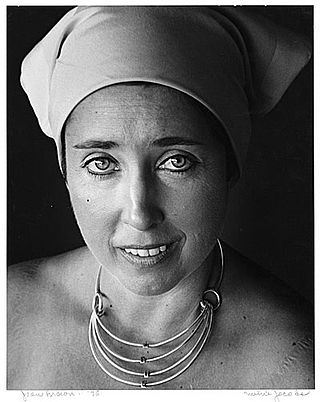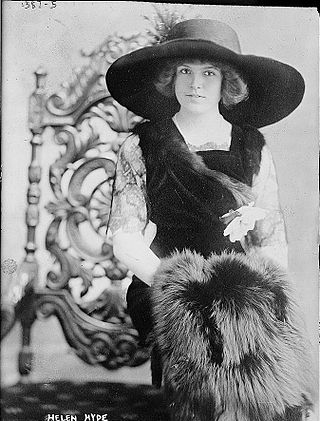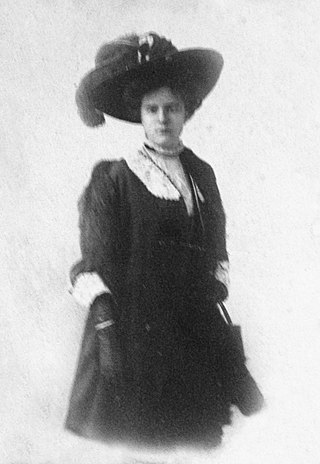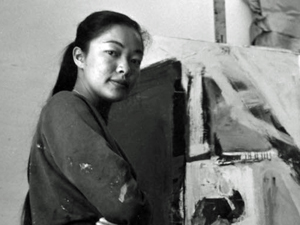Related Research Articles

Jay DeFeo was an American visual artist who became celebrated in the 1950s as part of the spirited community of Beat artists, musicians, and poets in San Francisco. Best known for her monumental work The Rose, DeFeo produced courageously experimental works throughout her career, exhibiting what art critic Kenneth Baker called “fearlessness.”
Asian American Women Artists Association (AAWAA) is a nonprofit arts organization that supports and promotes the work of Asian American women artists in the visual, literary, and performing arts through activities such as art events, lectures, artists salons, and member exhibitions.

Joan Brown was an American figurative painter who lived and worked in Northern California. She was a member of the "second generation" of the Bay Area Figurative Movement.

Helen Hyde was an American etcher and engraver. She is best known for her color etching process and woodblock prints reflecting Japanese women and children characterizations.

Chiura Obata was a well-known Japanese-American artist and popular art teacher. A self-described "roughneck", Obata went to the United States in 1903, at age 17. After initially working as an illustrator and commercial decorator, he had a successful career as a painter, following a 1927 summer spent in the Sierra Nevada, and was a faculty member in the Art Department at the University of California, Berkeley, from 1932 to 1954, interrupted by World War II, when he spent a year in an internment camp. He nevertheless emerged as a leading figure in the Northern California art scene and as an influential educator, teaching at the University of California, Berkeley, for nearly twenty years and acting as founding director of the art school at the Topaz internment camp. After his retirement, he continued to paint and to lead group tours to Japan to see gardens and art.
Squeak Carnwath is an American contemporary painter and arts educator. She is a professor emerita of art at the University of California, Berkeley. She has a studio in Oakland, California, where she has lived and worked since 1970.

Alice Brown Chittenden was an American painter based in San Francisco, California who specialized in flowers, portraits, and landscapes. Her life's work was a collection of botanicals depicting California wildflowers, for which she is renowned and received gold and silver medals at expositions. She taught at the Mark Hopkins Institute of Art from 1897 to 1941.
Helena Wood Smith was an American artist.

Mary Evelyn McCormick was an American Impressionist who lived and worked around San Francisco and Monterey, California at the turn of the 20th century.

Betty Guy was an American artist, most notable for her work in watercolor landscapes.

Bernice Bing was a Chinese American lesbian artist involved in the San Francisco Bay Area art scene in the 1960s. She was known for her interest in the Beats and Zen Buddhism, and for the "calligraphy-inspired abstraction" in her paintings, which she adopted after studying with Saburo Hasegawa.
Flo Oy Wong is an American artist, curator, and educator, of Chinese-descent. She had co-founded the Asian American Women Artists Association (AAWAA) in San Francisco.
Kim Anno is a Japanese-American artist and educator. She is known for her work as an abstract painter, photographer, and filmmaker. Anno has served as a professor, and as the chair of the painting department at the California College of the Arts in San Francisco.

Hisako Shimizu Hibi (1907–1991) was a Japanese-born American Issei painter and printmaker. Hibi attended the California School of Fine Arts in San Francisco, California where she garnered experience and recognition in the fine arts and community art-exhibition. Here, she met her husband George Matsusaburo Hibi, with whom she raised two children, Satoshi "Tommy" Hibi and Ibuki Hibi.

Helen Katharine Forbes was a Californian artist and arts educator specializing in etching, murals and painting. She is best known for western landscapes, portrait paintings, and her murals with the Treasury Section of Fine Arts and Work Progress Administration (WPA). Forbes was skilled in painting in oil, watercolor, and egg tempera. She painted landscapes of Mexico, Mono Lake and the Sierras in the 1920s, desert scenes of Death Valley in the 1930s, and portraits and still-lifes.
Cindy Shih is a Taiwanese-born American visual artist. Her work is strongly rooted in traditional techniques and principles, including Chinese literati painting, Venetian plasterwork, landscape painting, and realism, although producing thoroughly modern pieces. One of her prominent themes is exploring her personal narrative in a broad context. She lives in San Francisco, California.
Eva Joseph Goldsheid was a German-born American artist and educator, known as painter, and printmaker.
Emiko Nakano (1925–1990) was an American abstract expressionist painter, printmaker, fiber artist, and fashion Illustrator.
Na Omi Judy Shintani is a Japanese American artist whose work focuses on storytelling and remembrance of people who were imprisoned, her initial focus being Japanese Americans incarcerated during World War II. Shintani is known for creating interactive works about historical issues.
Ellen Reiko Bepp is an American contemporary artist working in mixed media. She has been recognized for her contributions to abstract expressionism, and her work with the artist group Sansei Granddaughters.
References
- ↑ "Betty Kano | Asian American Women Artists Association". aawaa.net. Archived from the original on 2016-04-02. Retrieved 2016-03-27.
- ↑ Albright, Thomas (1985-01-01). Art in the San Francisco Bay Area, 1945-1980: An Illustrated History. University of California Press. ISBN 9780520051935.
- ↑ "Betty Nobue Kano | An Idea Called Tomorrow". anideacalledtomorrow.wordpress.com. Retrieved 2016-03-27.
- ↑ Betty Nobue Kano Asian American Art and Activism. (2016). YouTube. Retrieved 20 March 2016, from https://www.youtube.com/watch?v=x9osV2X2vuM
- ↑ Sansei Legacy Project Home. (2016). Momomedia.com. Retrieved 20 March 2016, from http://www.momomedia.com/CLPEF/sansei/home.htm
- 1 2 3 4 5 6 7 8 9 10 Betty Kano | Asian American Women Artists Association. (2016). Aawaa.net. Retrieved 20 March 2016, from http://aawaa.net/artist-profile/betty-kano/ Archived 2016-04-02 at the Wayback Machine
- ↑ Kano, Betty (1993-01-01). "Four Northern California Artists: Hisako Hibi, Norine Nishimura, Yong Soon Min, and Miran Ahn". Feminist Studies. 19 (3): 628–642. doi:10.2307/3178104. hdl: 2027/spo.0499697.0019.310 . JSTOR 3178104.